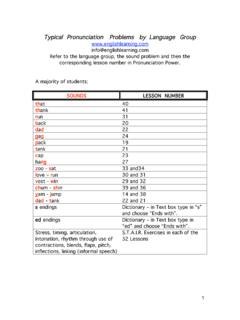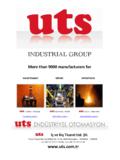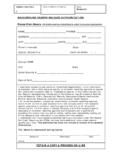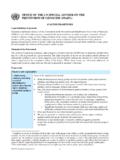Transcription of Conducting a Strategic Assessment - OD Group
1 Linking Strategy and Process, Part 2 Conducting a Strategic Assessment In part one of this series we discussed the different ways to leverage process performance and the importance of linking process and strategy. In part two we will discuss how to gather strategically critical information via a comprehensive Assessment process. The mechanisms for process evaluation identified in part one are an important part of this Assessment , but do not give the complete picture. This article begins with an explanation of the importance of establishing a Strategic direction and proceeds through the different phases of the Assessment process. Consistency of Direction It is impossible to develop a strategy without first understanding the vision and mission of the organization.
2 These concepts have been defined many different ways. The most useful definition Orion has found for a vision is a statement that describes the ideal future state of the organization, or where do we want to be 5-10 years down the road. A mission is a more grounded statement that conveys the organizational purpose, or what the organization is here for . Creating a precise mission and vision often turns into an excruciating exercise. Many companies have a tendency to lose focus; they get lost worrying about the precision of the verbiage of the statement versus where they want to take the company. Avoid this by keeping in mind that the important thing is for all key parties have a consistent understanding of the organizational direction.
3 Spend enough time on vision and mission to achieve this objective, then leave the polishing to the communication experts. Conducting a Strategic Assessment Once the ideal future state has been defined, the Assessment may begin. The purpose is to determine the key organizational strengths, weaknesses, opportunities, and threats (SWOTs) that will impact the organization s ability to get where it needs to go. Strategic planning textbooks have suggested there are five basic considerations to be taken into account when describing the ideal future state of the organization: financial, customer, process, technology, and people. It should come as no surprise that these are the building blocks to a successful Assessment as well.
4 Strategic AssessmentFinancialCustomerProcessPeople Technology A brief description of each phase of the Assessment follows below. Financial Assessment is relatively straightforward. It involves balance sheet analysis, determination of funding available for plan execution, forecasting, etc. This is obviously critical information when making a determination of how many initiatives can be supported and how aggressive they can be. Trend analysis should be performed on all key financial indicators. Control charts are invaluable tools to facilitate this analysis. Consider the example below: Monthly SalesCL= (Thousands) Typical analysis of this type of information yields a series of explanations for each rise and fall in the data, complete with variance analysis, deviation from plan, etc.
5 This is supplemented by sales personnel explanations for how in some months (eg- June of year two) there were market forces beyond their control that caused a drop in sales, while in other months (eg- August of year one) the true skill of the sales force shown through. Control charts provide a more objective analysis (and save a lot of time) by setting limits on how much variation is common due to everyday factors versus variation that represents a truly unusual special event that is attributable to a specific cause. It is important to note that these limits are calculated based on simple statistical formulas; limits should not be set wherever you desire them to be. The above example with the calculated limits drawn in is as follows: Monthly SalesUCL= (Thousands) UCL and LCL represent upper and lower control limits.
6 These distinguish the expected from the unexpected. The fact that this example shows only common cause variation means that no month is significantly different than any other. Trying to explain highs and lows on this graph is an unproductive waste of time. Any rebate programs, sales incentives, etc. this company might have offered during this time frame did not have the desired effect of significantly increasing sales. Nor did new products, new competitors in the marketplace, seasonal demand, etc. Evaluating financial information in this manner can greatly assist in the identification of key cause-and-effect relationships between organizational actions and financial results that will impact the ability to achieve the vision.
7 Customer assessments can be a bit more involved. The first step is to determine who you want your customers to be in the future, given that you achieve your ideal future state. What type of characteristics does a quality customer have, and how do we attract and keep them? Only after this question is answered can the Assessment proceed. There are numerous techniques available to assess customers and the marketplace. The Orion system map is a perfect tool for evaluating the interactions and relationships between the company and each of its distinct market segments. A sample system map is shown below: ABC ConstructionInputsOutputLarge AccountsCustomerSubs**EngineersArchitect sRegulatorsClientsSuppliersFeed Forward Feedback Feed Forward Feedback Feed Forward From Supplier:1.
8 Informal2. Informal3. InformalCustomer Expects: Gets: 1. Easy to deal with Excell2. Reliable (keep prom) Excell3. Competitive price Poor4. Good terms Good5. One-stop shop(some) Good-6. Security Excell7. Flexibility (custom) Excell8. Expertise Excell9. Service ExcellSupplier Specs: WeGet:1. Transparency Poor-Exc2. Truth Poor-Exc3. Timely/acc resp Poor-Exc to queries4. Quality data Poor-ExcFeed Forward To Customer1. Progress reports2. Phone to key clients3. Workshops / seminarsFeedback to Supplier:1. Contract review2. Face-to-face3. Phone/ emailFeedback from Customer:1.
9 Face-to-face2. Phone/email3. Service specsGap AnalysisGap AnalysisO1O4O5 Internal gap-causing issues:1. Pricing Policy2. Systems problems3. Poor project mgmtMost important gap:Competitive priceI1I2I3I4I5HQ This example is from a construction company attempting to differentiate itself from its competitors through offering superior service. This is an unusual strategy in an industry that is heavily price-driven, but this company believes that service considerations will override the price-focus for their target client Group . The oval on the right illustrates that this system map is evaluating the relationship between the company and its large account customers. The box in the lower right-hand corner provides an analysis of the large clients needs and how well each is being met.
10 Note that each service item is rated good or excellent except for price. The top-right portion is the where the most important gap / area for opportunity exists, and price is selected as the most important. The internal gap-causing issues section reflects that pricing policy is indeed a key contributor to the gap, but it isn t the only one. Systems problems and poor project management are also driving the price up. The system map has therefore helped identify two internal issues that could prevent the execution of the stated strategy. The rest of the diagram contains important information as well. The supplier analysis on the left-hand side reveals that subcontractors are the major inhibitors to the company s ability to satisfy its customers.





